Study: Vaping Statistics by State
The legal age to buy e-cigarettes ranges from 18-21 in most states, but West Virginia is the state with the most high school students who admit to vaping underage. We rank all 50 states for both teen and adult vapers, look at death rates and review the e-cigarette regulations in every state.
- Last update: March 12, 2025
- 35.7% of West Virginia high school teens admit to currently using electronic vaping products, the highest percentage in America.
- 17% of West Virginia middle schoolers are vaping, more than five times the national average.
- 77% of teens who use tobacco products state their first tobacco-related product was an e-cigarette.
- Almost 10% of Oklahoma adults vape every day, making the state home to more adult vapers than any other U.S. state.
States With the Most Teen Vapers
More high school teenagers in West Virginia admit to having used vaping products within the last 30 days than anywhere else in the country, at 35.7%. That’s more than double the national percentage of high school students who use e-cigarettes, which is 14.1% (representing 2.14 million teens).
These numbers are troubling, considering scientists agree that while vaping is less harmful than smoking traditional cigarettes, e-cigarettes are not considered safe for human health overall. These safety issues are more severe for adolescents, with studies linking vaping to bad outcomes ranging from higher rates of pneumonia to poor academic performance.
A recent outbreak of e-cigarette or vaping use-associated lung injuries, known as EVALI, impacted vapers of all ages across the U.S., confirming the potential risks of unregulated e-cigarette ingredients.
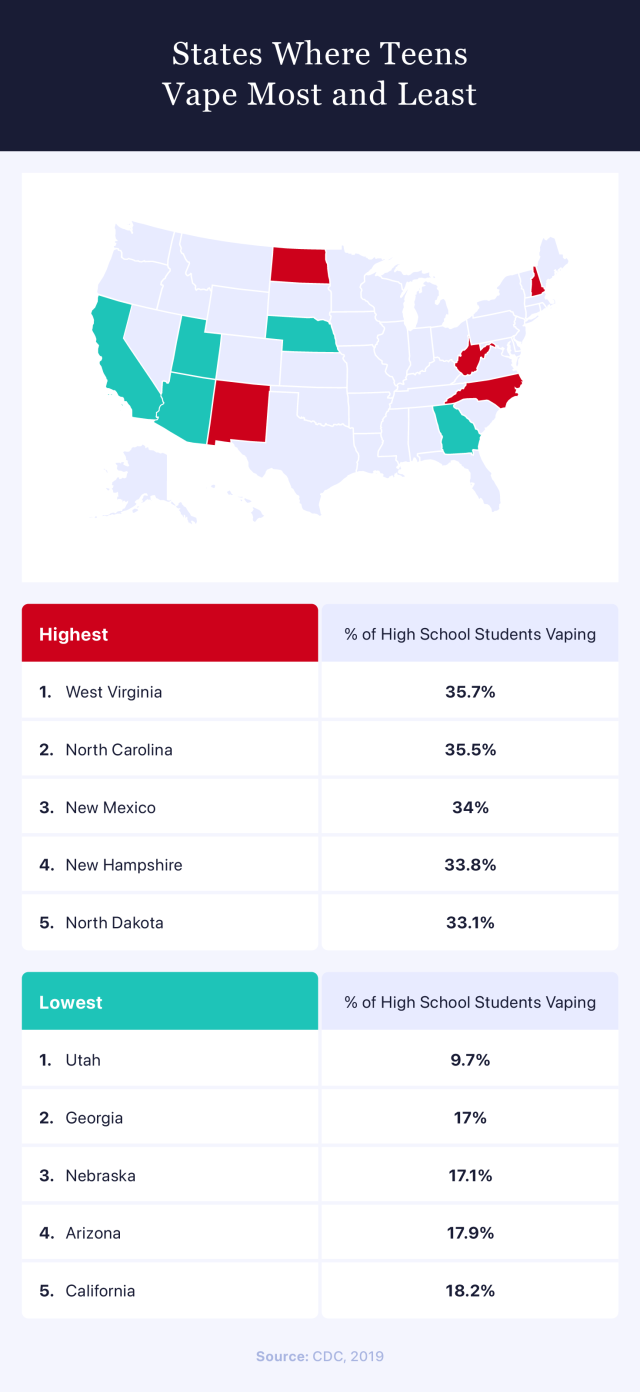
North Carolina (35.5%), New Mexico (34%), New Hampshire (33.8%) and North Dakota (33.1%) round out the top five states with the highest percentage of students vaping.
Some middle school students are also engaging in vaping use. Nationally, 3.3% of them reported current e-cigarette use. In West Virginia, that number skyrockets to 17% of the state’s middle schoolers, revealing the state to once again have the highest numbers in the U.S.
A national study revealed that in 2021, 77% of teens who acknowledged using tobacco products specified their first tobacco-related product was an e-cigarette. Compare that to the 2014 data, when only 27% of tobacco-using teens made the same admission.
One state that seems to be doing something right when it comes to vaping statistics is Utah. The state has the nation’s lowest percentage of high school students currently using e-cigarettes, at only 9.7%. And when you examine Utah’s yearly health care costs directly tied to smoking, the number is less than half of what is seen in Oklahoma ($630 million vs. $1.88 billion, respectively). The low rates of vaping in Utah have been attributed to the state’s strong investment in anti-vaping programs.
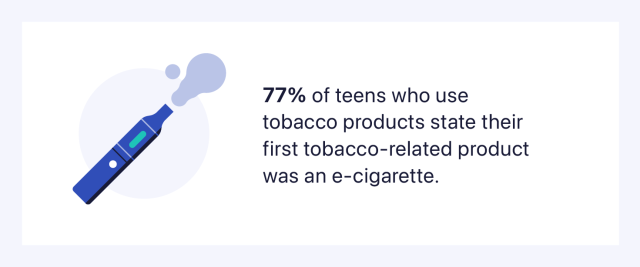
How All 50 States Rank
The high percentage of teens using vaping products in each state is less surprising when you consider that research has shown kids are twice as sensitive to tobacco advertising as adults.
Targeted marketing of flavored e-cigarettes to kids has been incredibly successful. Eighty-five percent of current vape enthusiasts of all ages opt for flavored e-cigarettes, with the most popular flavor options being fruit, candy and other sweet dessert-like flavors. The popularity of e-cigarettes continues to grow across the country, with revenue in the vaping products market projected to reach $8.28 billion in 2023.
| Rank | State | Percentage of High School Teens |
|---|---|---|
| 1 | West Virginia | 35.7% |
| 2 | North Carolina | 35.5% |
| 3 | New Mexico | 34% |
| 4 | New Hampshire | 33.8% |
| 5 | North Dakota | 33.1% |
| 6 | Massachusetts | 32.2% |
| 7 | Hawaii | 30.6% |
| 8 | Maine | 30.2% |
| 9 | Montana | 30.2% |
| 10 | Rhode Island | 30.1% |
| 11 | Ohio | 29.8% |
| 12 | Colorado | 28.9% |
| 13 | Oklahoma | 27.8% |
| 14 | New Jersey | 27.8% |
| 15 | Connecticut | 27% |
| 16 | Vermont | 26.4% |
| 17 | Kentucky | 26.1% |
| 18 | Alaska | 26.1% |
| 19 | Pennsylvania | 24.4% |
| 20 | Arkansas | 24.3% |
| 21 | Nevada | 24.1% |
| 22 | South Dakota | 23.9% |
| 23 | Maryland | 23% |
| 24 | Louisiana | 22.9% |
| 25 | New York | 22.4% |
| 26 | Tennessee | 22.1% |
| 27 | Kansas | 22% |
| 28 | Idaho | 21.5% |
| 29 | Mississippi | 21.4% |
| 30 | South Carolina | 21.1% |
| 31 | Michigan | 20.8% |
| 32 | Missouri | 20.7% |
| 33 | Wisconsin | 20.6% |
| 34 | Iowa | 20.1% |
| 35 | Virginia | 19.9% |
| 36 | Illinois | 19.9% |
| 37 | Alabama | 19.4% |
| 38 | Texas | 18.7% |
| 39 | California | 18.2% |
| 40 | Arizona | 17.9% |
| 41 | Nebraska | 17.1% |
| 42 | Georgia | 17% |
| 43 | Utah | 9.7% |
| Delaware | No data available | |
| District of Columbia | No data available | |
| Florida | No data available | |
| Indiana | No data available | |
| Minnesota | No data available | |
| Oregon | No data available | |
| Washington | No data available | |
| Wyoming | No data available |
States With the Most Adult Vapers
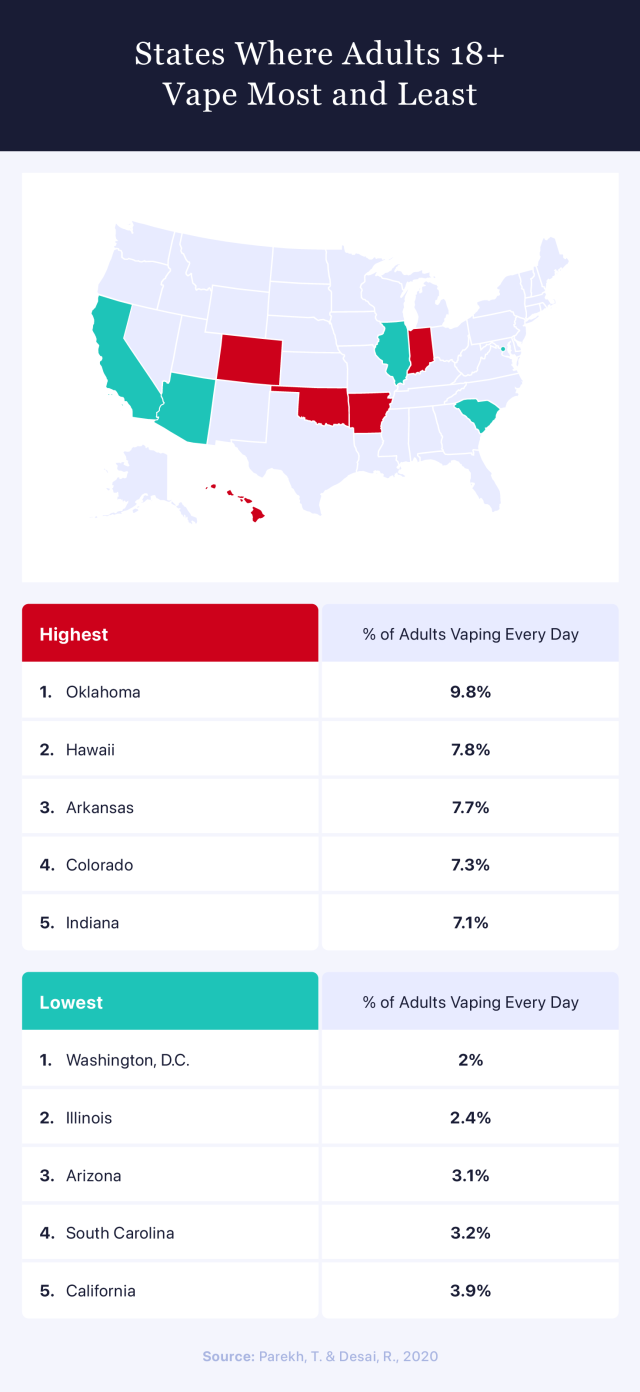
Of the 3.7% of U.S. adults who currently use e-cigarettes, the largest portion of those users reside in Oklahoma, representing 9.8% of the state’s population. With annual health care costs directly caused by e-cigarettes and traditional smoking combined at $1.88 billion in the state, Oklahomans take on a state and federal tax burden of $956 per household to cover smoking-related government costs.
It’s interesting to note that Oklahoma’s smoking cessation call line invests $9.18 per smoker, over four times the national average of $2.28. Although some claim vaping is a useful strategy to help quit smoking more harmful traditional cigarettes, it is not currently approved by the U.S. Food and Drug Administration as a smoking cessation aid. Additionally, there have been a variety of studies indicating that vaping is not an effective anti-smoking tool.
Following Oklahoma in the rankings, the next four states are all within one percentage point of each other in terms of vaping population. Hawaii came in second, with 7.8% of its adult residents using e-cigarettes every day. Only one-tenth of a percentage point behind is Arkansas at 7.7%. Colorado ranked fourth highest at 7.3%, with Indiana coming in fifth at 7.1%.
Conversely, Washington, D.C., is home to the lowest population of adults currently using vaping products. Only 2% of D.C. residents fall into this category. Other states with low totals include Illinois (2.4%), Arizona (3.1%), South Carolina (3.2%) and California (3.9%).
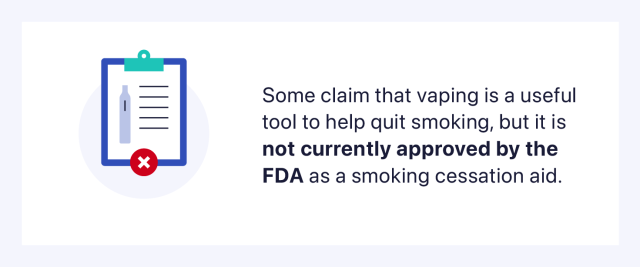
How All 50 States Rank
When comparing the percentage of vapers in every state, we discovered some interesting data points. There is a difference of almost 10% between Oklahoma — the state with the highest concentration of vapers — and Washington, D.C. — the area with the lowest prevalence.
How does your state compare?
| Rank | State | Percentage of High School Teens |
|---|---|---|
| 1 | Oklahoma | 9.8% |
| 2 | Hawaii | 7.8% |
| 3 | Arkansas | 7.7% |
| 4 | Colorado | 7.3% |
| 5 | Indiana | 7.1% |
| 6 | Florida | 7% |
| 7 | Wyoming | 7% |
| 8 | Kentucky | 6.8% |
| 9 | Idaho | 6.5% |
| 10 | Tennessee | 6.5% |
| 11 | Alabama | 6.4% |
| 12 | Michigan | 6.4% |
| 13 | Alaska | 6.2% |
| 14 | Maine | 6.2% |
| 15 | Missouri | 6.2% |
| 16 | Connecticut | 6.1% |
| 17 | Louisiana | 6.1% |
| 18 | Nevada | 6% |
| 19 | North Dakota | 6% |
| 20 | Oregon | 6% |
| 21 | Massachusetts | 5.9% |
| 22 | Mississippi | 5.9% |
| 23 | Ohio | 5.9% |
| 24 | Kansas | 5.8% |
| 25 | Nebraska | 5.8% |
| 26 | Rhode Island | 5.8% |
| 27 | Iowa | 5.7% |
| 28 | North Carolina | 5.7% |
| 29 | Georgia | 5.6% |
| 30 | New York | 5.6% |
| 31 | Texas | 5.6% |
| 32 | Minnesota | 5.4% |
| 33 | New Hampshire | 5.4% |
| 34 | Utah | 5.3% |
| 35 | Virginia | 5.3% |
| 36 | Delaware | 5.2% |
| 37 | Montana | 5.2% |
| 38 | Wisconsin | 5.1% |
| 39 | Maryland | 5% |
| 40 | South Dakota | 4.8% |
| 41 | New Mexico | 4.5% |
| 42 | Vermont | 4.1% |
| 43 | California | 3.9% |
| 44 | South Carolina | 3.2% |
| 45 | Arizona | 3.1% |
| 46 | Illinois | 2.4% |
| 47 | District of Columbia | 2% |
| New Jersey | No data available | |
| Pennsylvania | No data available | |
| Washington | No data available | |
| West Virginia | No data available |
Vaping-Associated Lung Injuries Outbreak by State
In 2019, hospitals began reporting to the Centers for Disease Control and Prevention an alarming increase in hospitalizations of patients with a known history of vaping who developed a severe lung illness. The CDC deemed it an EVALI outbreak and issued warnings to the public. By Feb. 18, 2020, the CDC had recorded 2,807 separate EVALI cases across all 50 states. Of that total, 68 patients died from their illnesses.

The states that experienced the highest number of cases were Illinois and Texas, with 200-249 cases of EVALI each. In fact, Texas was home to the outbreak’s youngest victim — a 15-year-old boy who died from EVALI. But it’s worth noting that the four states hit hardest by the outbreak (adding in California and New York, which each had 150-199 cases of EVALI) are among the top six most populated states in the country.
A Kaiser Family Foundation report released in October 2019, just after the peak of the outbreak in September 2019, revealed that 59% of adults had heard a lot about EVALI. This finding illustrated the public’s growing awareness of the tie between vaping and serious lung injury risks.
Considering the potentially harmful substances that could be found in e-cigarettes, increased awareness of these risks benefits public health overall. Although not as harmful as an actual cigarette, e-cigarette ingredients may include cancer-causing chemicals, ultrafine particles that are dangerous to inhale and flavoring chemicals linked to lung disease.
Vaping Laws by State
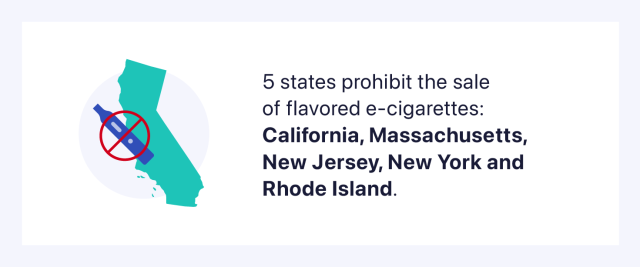
All 50 states have legislation in place that prohibits the sale of e-cigarettes to minors, and 30 states have also passed legislation that mandates a tax on e-cigarettes. The method of taxation varies from state to state — some of the tax policies focus on the volume of liquid in the vape product while others target prefilled cartridges.
In 2020, the FDA banned the manufacture, distribution and sale of fruit-flavored vaping products in an effort to reduce their growing popularity among American youth. But one recent study discovered that most adult vapers simply switched to flavored nicotine products not covered in the FDA’s ban or returned to smoking traditional cigarettes. Currently, five states have taken that ban further by prohibiting the sale of flavored e-cigarettes: California, Massachusetts, New Jersey, New York and Rhode Island.
Costs and regulations in each state may vary based on the type of vaping product purchased, such as disposable e-cigarettes vs. refillable e-cigarettes. The average annual cost to vape a JUUL, a popular brand of vaping products, is estimated at $1,008. The chart below outlines some of the key things to know if you plan to purchase e-cigarettes in your state.
| State | Is There an E-cigarette Tax? | Minimum Age to Purchase | Ban on Sales of Flavored E-cigarettes |
|---|---|---|---|
| Alabama | No | 21 | No |
| Alaska | No | 19 | No |
| Arizona | No | 18 | No |
| Arkansas | No | 21 | No |
| California | Yes | 21 | Yes |
| Colorado | Yes | 21 | No |
| Connecticut | Yes | 21 | No |
| Delaware | Yes | 21 | No |
| District of Columbia | Yes | 21 | No |
| Florida | No | 21 | No |
| Georgia | Yes | 21 | No |
| Hawaii | No | 21 | No |
| Idaho | No | 21 | No |
| Illinois | Yes | 21 | No |
| Indiana | Yes | 21 | No |
| Iowa | No | 21 | No |
| Kansas | Yes | 18 | No |
| Kentucky | Yes | 21 | No |
| Louisiana | Yes | 21 | No |
| Maine | Yes | 21 | No |
| Maryland | Yes | 21 | Partial |
| Massachusetts | Yes | 21 | Yes |
| Michigan | No | 18 | No |
| Minnesota | Yes | 21 | No |
| Mississippi | No | 21 | No |
| Missouri | No | 18 | No |
| Montana | No | 18 | No |
| Nebraska | No | 21 | No |
| Nevada | Yes | 21 | No |
| New Hampshire | Yes | 21 | No |
| New Jersey | Yes | 21 | Yes |
| New Mexico | Yes | 21 | No |
| New York | Yes | 21 | No |
| North Carolina | Yes | 18 | No |
| North Dakota | No | 21 | No |
| Ohio | Yes | 21 | No |
| Oklahoma | No | 21 | No |
| Oregon | Yes | 21 | No |
| Pennsylvania | Yes | 21 | No |
| Rhode Island | No | 21 | Yes |
| South Carolina | No | 18 | No |
| South Dakota | No | 21 | No |
| Tennessee | No | 21 | No |
| Texas | No | 21 | No |
| Utah | Yes | 21 | Partial |
| Vermont | Yes | 21 | No |
| Virginia | Yes | 21 | No |
| Washington | Yes | 21 | No |
| West Virginia | Yes | 18 | No |
| Wisconsin | Yes | 18 | No |
| Wyoming | Yes | 21 | No |
With millions of Americans of all ages using e-cigarettes, examining the most common vape ages per state serves as a data-backed resource for anyone considering their next puff or interested in trying to quit vaping. While vaping may offer some benefits to adult smokers when used as a full substitute for traditional cigarettes, it still poses a serious health risk for kids, teens, young adults and pregnant women.
Methodology
We examined the most recent data available on vaping in America to rank all 50 states based on their teen and adult vaping populations. We reviewed the most recently available information directly from the CDC, including statistics from its Youth Risk Behavior Surveillance System, and published research from medical experts in academic journals.
Calling this number connects you with a Drugwatch.com representative. We will direct you to one of our trusted legal partners for a free case review.
Drugwatch.com's trusted legal partners support the organization's mission to keep people safe from dangerous drugs and medical devices. For more information, visit our partners page.

